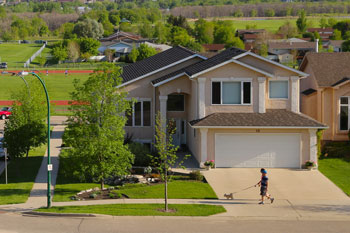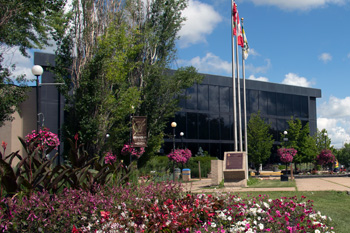Immediate Action
Water and fire-damaged records can often be saved by prompt action. Without proper emergency treatment, however, records may become damaged beyond repair.
Damp or soggy paper records deteriorate rapidly because of materials used in the fabrication of the paper itself. Within 24 hours, pages may begin to adhere to each other, but can still be separated without further damage. Legibility at this point depends upon the type of paper and kind of ink or writing materials used.
Within 48 hours, as the individual records in file folders stored inside filing cabinets begin to dry, the individual sheets of paper wrinkle and adhere to each other. The longer the records remain in the folders and cabinets, the more difficult the restoration process becomes. The task of separating individual documents is almost impossible and legibility is progressively impaired.
If water-soaked records, housed in folders and filing cabinets, are allowed to dry intact for about 5 days, mold from bacteria action will begin to form. If the documents remain in that state for a longer period of time, they will form a hard mass. Restoration at this point is very difficult, if not impossible.
Generally, records stored in the lower drawers of a filing cabinet receive the most water during the firefighting process. Dampness from lower drawers will often spread to records in the upper drawers, particularly if the filing cabinets are made of wood. Therefore, top drawers should be opened slightly to facilitate the movement of air. Damp records in the lower drawers should be removed as soon as possible. Storage of valuable records in lower drawers, where they are most susceptible to damage should be avoided.
A potential fire hazard from delayed ignition is often present when opening filing cabinet drawers that have been subjected to intense heat. Such ignition has occurred as long as three days after a cabinet has been removed from the scene of a fire. Drawers should be opened cautiously after the container has cooled below the sizzling point. Suitable hand fire extinguishers, or some means of producing a fine water spray, should be available when the drawers are opened in case flash ignition occurs.
Recovery
When there is large scale fire and water damage to valuable records, remove the filing equipment containing these records from the scene of the fire as soon as possible. If practical, remove such equipment first, before removing any other office equipment. The other office equipment and machines are replaceable or repairable. In many cases, records cannot be replaced. The element of time is primary in restoring records.
Arrangements should be made as soon as possible for well-protected vacant ground floor space, preferably store-type rather than a warehouse, for temporary storage of records to be salvaged. Warehouse space is more likely to be unheated and poorly lighted. The area should be large enough to provide working space for salvage operations with sufficient light to identify the records. Such space should be well heated with good circulation of air to combat mold formation. The ideal condition is a temperature of 25-30 degrees Celsius (80-90) degrees Fahrenheit) with humidity below 60 percent.
Filing cabinets should be arranged in the temporary space so that all file drawers can be readily opened. This can best be done by lining the cabinets along the outside walls with the drawers facing the middle of the room. The method to use depends upon the number of cabinets involved and the amount of floor space available.
Extreme care should be used in handling cabinets witch may be hot, splintered, or unusually heavy due to water-soaked records. Improper lifting and moving of filing cabinets may cause serious strains, back injury and/or hernias. Protective gloves should be worn to avoid injuries.
Salvage Operations
As soon as the damaged records are moved into temporary storage, partially open each file drawer. Care should be taken not to topple cabinets through overbalance from opening top drawers too far. Again, during this process, a hand fire extinguisher should be available in case of spontaneous combustion.
Carefully examine the contents of each drawer to determine the type and extent of the damage. As the files are examined, note on the front of each drawer by use of coloured chalk or paper tags the type of damage; for example W- waterlogged, D- damp, F - fire, singed or scorched, and X - destroyed.
Consult with the individuals who are responsible for maintaining the company's files to determine and locate various categories and series of records that have been identified, determine whether or not the damaged records are duplicated elsewhere. For example, at headquarters or at a subordinate office, or in an alternate file within the filing system.
Then determine if any of the damaged records are of such temporary value that their reclamation is unnecessary or uneconomical. Start reclamation of records that should be saved in the following order: vital records, program records, housekeeping records and non-documentary material. Wet or damp records should not be dried by sunlight or direct application of heat, such as laying the papers on top of radiators or furnace registers. Several recommended methods of drying records follow:
- Fast Drying
Use a large blueprint or photographic dryer, with a metal cylinder about 126 cm long and 3 cm in diameter (42 x 10 inches), electrically heated with a thermostat control. Five legal-size or letter-size papers can be dried simultaneously on a dryer of this size. Care should be taken not to allow the cylinder to become too hot. Excessive heat will scorch the paper. It is better to re-run documents through the dryer several times until they are completely dry. Most commercial firms that do blueprinting or photography have such dryers.
-
Slow Drying
-
Use a photocopy dryer with a metal cylinder about 81 cm long and 84 cm in diameter (27 x 28 inches), electrically heated and with thermostat control. This is similar to the blueprint dryer except that it dries paper much less rapidly. However, it is more suitable for large documents. Such a dryer is also available at most blueprinting or photographic reproduction firms.
- Room or Space Drying
-
Spread records on the floor or on tables in a warm or hot room with an air-circulating fan running at low speed. It will be necessary to turn the documents periodically. The drying process can be greatly accelerated and large quantities of wet records quickly and effectively handled by ironing with mangles.
- Clothesline Drying
Hang documents on a clothesline strung in a warm or hot room - a boiler room is ideal. Periodically, about every 2 hours, reverse the documents on the clothesline. Wet documents can be dried by this process in approximately 30 to 48 hours. This method is very good for drying large individual documents such as blueprints, land plots or sectional maps.
- Bound Volumes
Stand bound volumes on end with their covers spread. Interleave pages with blotting paper, absorbent paper towelling or tissue, periodically changing it as it becomes damp. After the bindings of the volume have become moderately dry by exposure to the air, simple jackets of heavy waxed paper should be made for them so that the books may be laid flat with the covers closed without risk of the binding cloth sticking or staining.
Pages should then be examined, separating them from each other if necessary by inserting a thin spatula and again interleaving the sheets with thin blotters between them. Place the books under light pressure using common building bricks, if necessary, to flatten the sheets and eliminate warping of the covers. Blotters should be changed as necessary.
- Maps
Place fairly well-dried maps and other oversize documents between waxed paper and then in turn between white blotters and pieces of corrugated paper. This arrangement may be built up to include a number of maps and then weighted until drying is complete. A large piece of wallboard, weighted by bricks, will provide even pressure. The maps should remain under pressure for several days to prevent curling or buckling.
- Film
Place water-soaked film in a large tank (suck as a plastic swimming pool) containing cool, clear water. This will keep the film wet and prevent it from sticking together. Mud and other debris need to be removed but should be washed off carefully to avoid scratching the film. The film should then be bathed in a photographic hardening solution to protect the emulsion, spray-washed, and dried. This first-aid treatment is effective if salvage operations are concluded quickly. Film is subject to damage from prolonged exposure to water through action of fungi, mold and mildew. Dry film that has been contaminated by soot, oil or dirt should be cleaned with a dry cleaning agent.
- Microfilm
Waterlogged microfilm can be revived if it receives first aid. The 16 mm Microfilm Records of the Pennsylvania Electric Company in Johnstown spent 8 days submerged in floodwater after a disaster. Today that film is back in service, thanks to the no-charge reclamation services that Eastman Kodak Co. (Rochester, N.Y.) provided its customer.
"Being immersed in water often does little or no damage to microfilms, if they're kept wet with fresh water", reports Gill Miller, Manager of Kodak's Microfilm Processing Laboratory in Pittsburgh. "Acids, chemicals, or silt in the flood-water that might scratch the film are the main dangers." He suggests the following to prevent permanent water damage:
- Fill any large, clean container (such as a garbage or milk can) with fresh water.
- Place the film (in their cartons) completely underwater.
- Cover the container and send it to the nearest commercial processing centre
- Magnetic Tape, Memory Cores and Related Devices
Protect magnetic tape and related material from heat and moisture. Images that comprise the documentation are distorted or obliterated by exposure to a degree of heat and moisture that would not damage paper records. Once distorted or obliterated, these images cannot be restored. Thus, recovery measures will achieve little success.
Here, the only sure protection is storing duplicate records in a separate area not subject to the same fire. In some operations, duplications on the same or different media is a common practice.
The increasing use of electronic equipment to handle large or complex quantities of work results in the concentration in a single location of recorded data that is of the utmost importance. The data, as well as the equipment, deserves proper protection. Methods to achieve maximum protection are available from the equipment manufacturer.
- Singed or Scorched Records
Carefully handle singed, scorched or charred records; dry them slowly and duplicate those that are seriously damaged. Charred records should be handled as little as possible to avoid crumbling. Even though they appear completely ruined, illegible charred documents can often be read by exposure to invisible ultraviolet light in total darkness
- Intrinsically Valuable Records
Seek professional advice if the damaged records are unique and merit preservation in their original form. Drying alone is not sufficient to preserve fine books, unique maps and other irreplaceable documents. Lamination and other treatments are often necessary to prevent damage; however, professional advice should be sought for these measures.
- Freeze Drying Process
Valuable papers, unique copies of works, treasured keepsakes and art objects can often be restored by freeze-drying. The important thing is to get the damaged object you want to save into a freezer immediately. You will then have time to inquire about services to carry out the restoration. The conservator at the Thomas Fisher Rare Book Room is one source of advice (416) 978-7265.
Another source of information regarding freeze-drying is The Canadian Conservation Institute in Ottawa, which has a 24-hour answering service.







